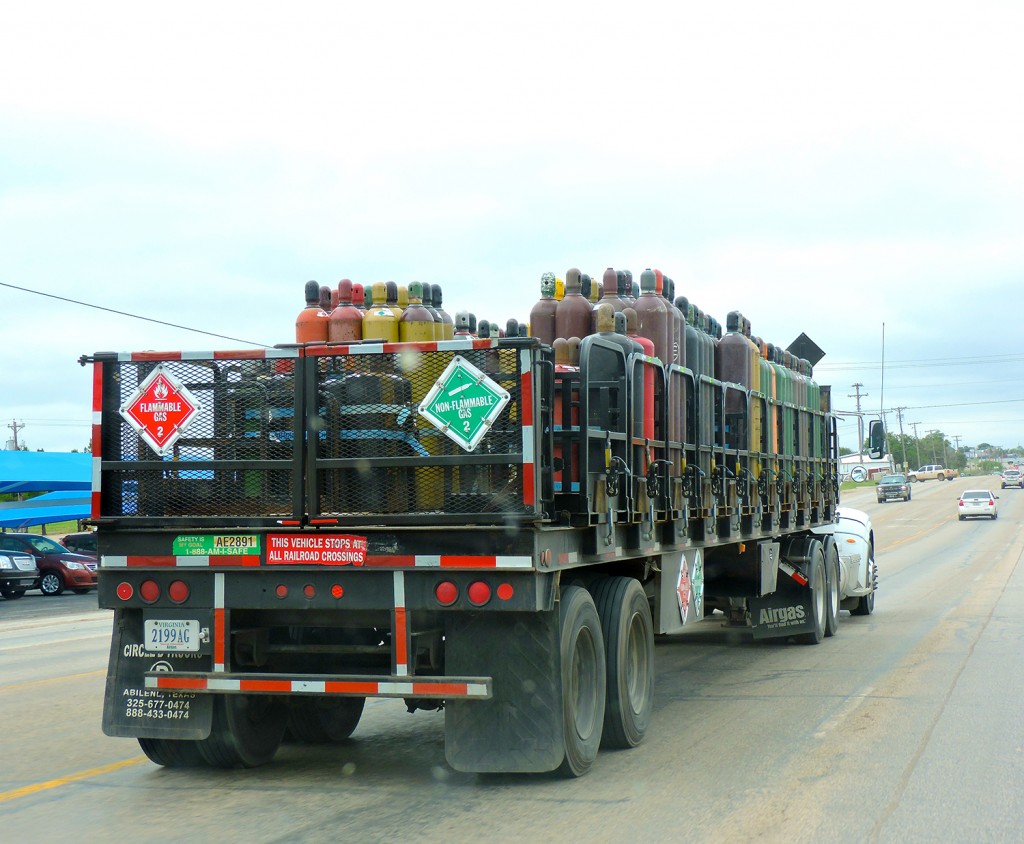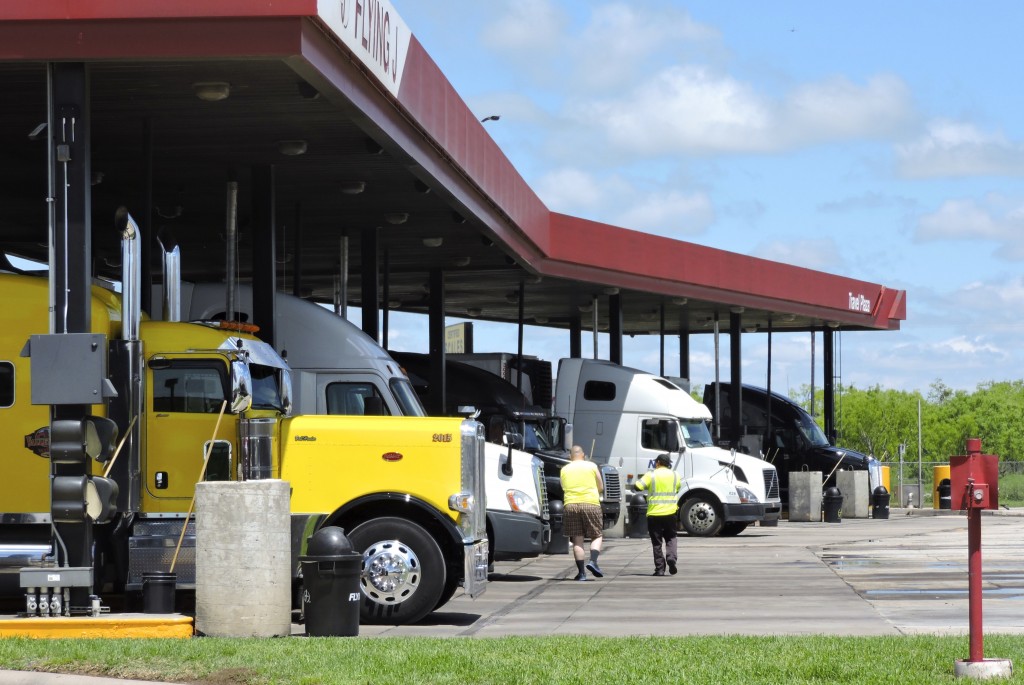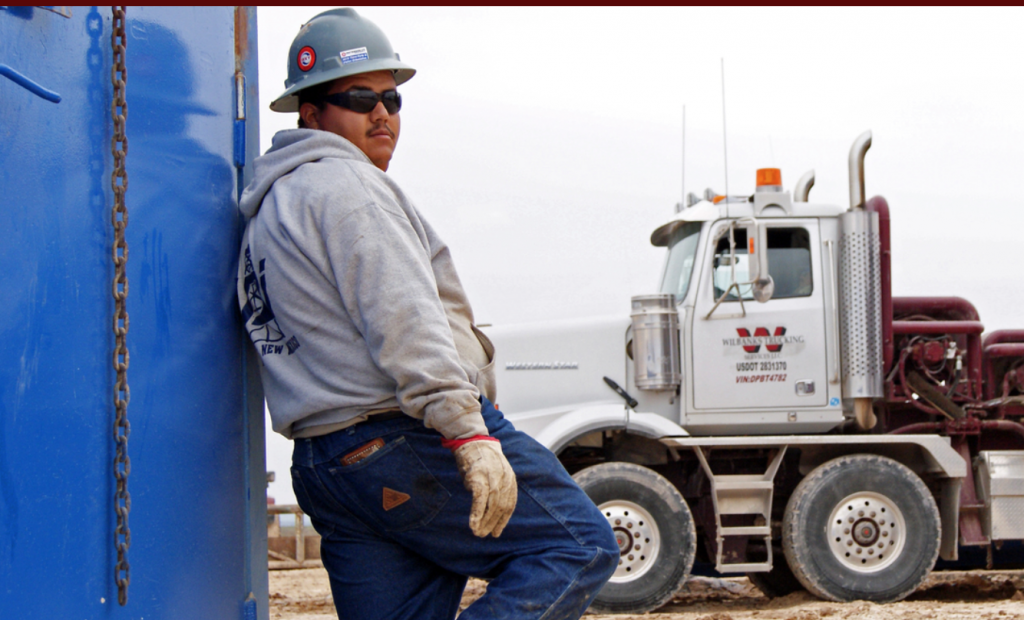by Hanaba Munn Welch
By another name, highways are arteries. The truck traffic that flows over them is the lifeblood of the economy, carrying goods and services in every direction. When the big rigs are rolling across America, the economy is rolling too.
Trains and planes and barges also carry the stuff of commerce, but trucks are more visible in more places—a veritable barometer of the economy that anyone can read, either by gathering and analyzing statistics posted on the web, or by sitting on the front porch and counting the trucks that whiz by on the highway. Or both.
Has the downturn in the price of oil and fuel costs affected the flow of the trucking business across the country? It’s a complicated question, even for economists, who tend not to agree on things till the dust settles, if even then. Bottom line, trucking isn’t booming, not even now that fuel costs are down—in fact, maybe because of the drop in prices of crude and its derivatives.
The scenario isn’t the same everywhere, but statistics from DAT Solutions indicate the trucking business in general has slowed down over the last couple of years. DAT (originally Dial-A-Truck) doesn’t reflect everything that’s happening in trucking, but it comes close, describing itself as “the world’s largest freight marketplace and information provider”—not bad for a company that started as a bulletin board in a truck stop in Portland, Ore. (See Wikipedia.) On DAT’s “load boards,” brokers and carriers post loads and trucks, making it a place where spot market needs meet solutions and information flows.
Load-to-truck ratios can be determined from DAT data—ratios that provide a picture of what’s happening relative to fluctuating supply and demand factors and, viewed through the right crystal ball, what may happen next.
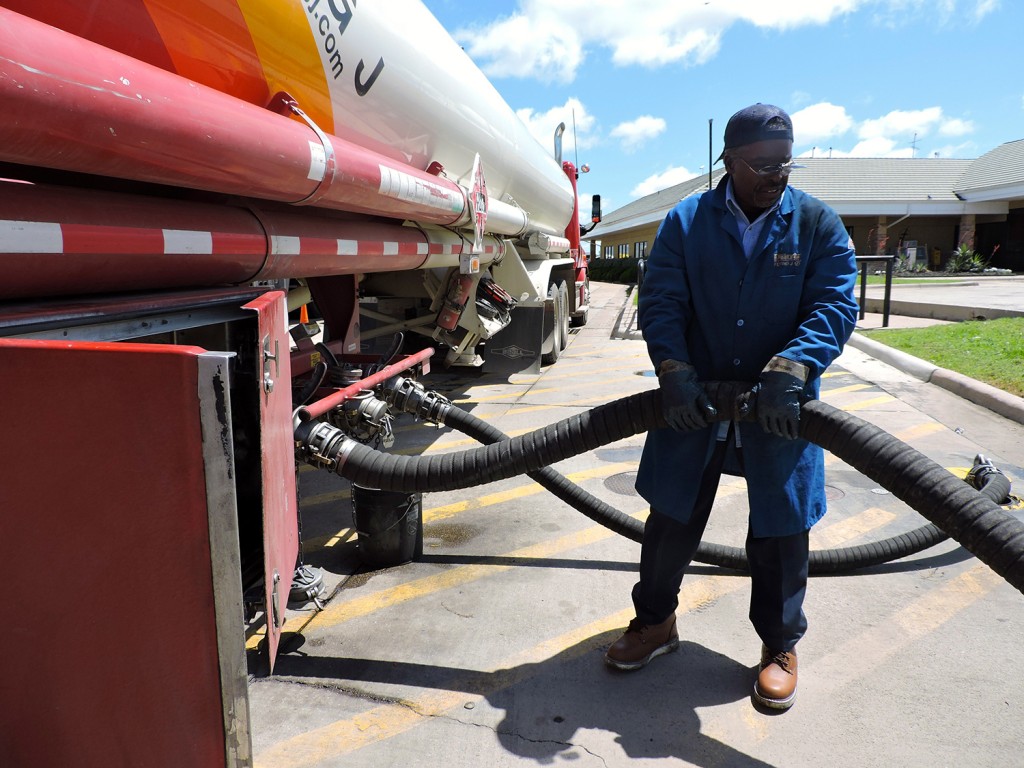
Richard Jones prepares to disconnect a fuel transfer hose from his Flying J fuel truck. When oilfield activity was at its peak in 2014, Jones worked overtime to keep the tanks filled at the Flying J near Abilene, and trucks waited in line at the pumps.
Flatbed trucks are the workhorses that haul equipment to places like the oilfield. For flatbeds, a DAT graph of load-to-truck ratios in 2014, 2015, and the first quarter of 2016 shows the ratio has been down the last couple of years compared to 2014, when the most recent downslide in oil prices began. When oil was $100 a barrel in mid-2014, the 2014 load-to-truck ratio shows a corresponding peak on the DAT graph. For the rest of that year, the slide corresponds roughly to the downturn in the price of oil. Taken at face value, the connection seems clear. An economist’s analysis of information behind the charts might produce a different conclusion, but the graphic correlation doesn’t change. Oil is down and so is the flatbed truck business.
In the real world, people—not statistics—tell the story. Everybody has one, from the freelance hot-shotter with a one-ton winch truck to the owners of companies that maintain fleets of rig-hauling equipment.
Lance Wilbanks falls in the latter category. He’s CEO of Wilbanks Trucking Services, LLC.
“We’re primarily rig movers,” Wilbanks said by phone in an interview with PBOG. “We have a nice little niche over here in New Mexico.”
The business of moving rigs is much slower now than when activity in the Permian was booming, Wilbanks said. “We’re surviving,” he said.
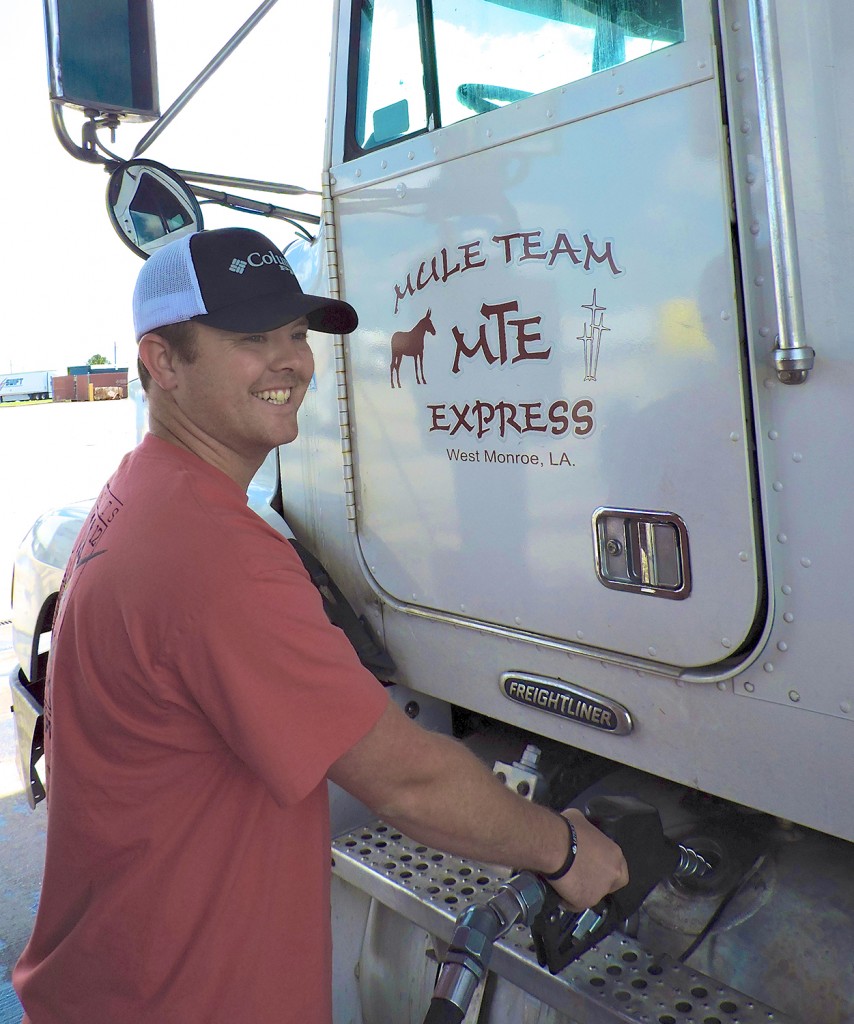
Chris Thornton is quick to smile, happy his work is fairly steady despite the slump in the price of oil.
Mule Team Express delivers fluids to frac’ing operations and tubular materials to refineries. He’s looking
forward to better times.
The trickle-down effect of the slowdown means fewer jobs for the rig-hauling workforce. Wilbanks employees understand the belt-tightening situation. “Most of them are just happy to have a job,” he said.
Incidentally, the history of Wilbanks’ company exemplifies the sort of cyclical sell-and-buy-back phenomenon that sometimes happens in the oil business, a function of the unpredictable ups and downs in prices for crude.
Ronnie Wilbanks, father of Lance, founded the company in 1987. From humble beginnings, the Wilbanks business grew over the years and sold in 2013 to become Wilbanks Energy Logistics, with Lance Wilbanks staying on board as CEO. Times were good. Investors were upbeat. Who knew things would change?
The Wilbanks Energy Logistics website still describes itself as the vibrant company it was when the price of oil was high. But Wilbanks Energy Logistics is now in receivership.
When the bankruptcy happened, the Wilbanks family bought back most of the assets of the company “at a significant discount,” in the words of Lance Wilbanks. It was a fortuitous outcome he and his father could not have predicted.
“Dad said that God takes care of the ignorant,” Wilbanks said.
Chimney corner scripture also says that God takes care of those that take care of themselves. For Wilbanks Trucking, that means taking care of all the business they can in their corner of the Permian—not just moving rigs but also other heavy haul trucking, forklift services, knucklebooms, hot-shot deliveries, pipe moving and pipe storage, tank moving and setup, and crane services.
Wilbanks acknowledges that fuel is one of his company’s highest costs. But he’d pay higher fuel costs with a smile if they were tied to an upswing in prices for crude and more business for his company and everyone else in the Permian.
Based in Carlsbad, N.M., Wilbanks Trucking Services also operates from locations in Artesia and Hobbs. The company also maintains a strong presence on their website (www.wilbanks.us), as well as on LinkedIn and Facebook.
Fluctuations in the price of crude don’t have as great an effect on trucking businesses tied to existing production as they do on upstream players like Wilbanks. But Greg Berry, who buys and sells crude for BML, Inc., in Abilene, would like to see prices take an upward turn. He talked to PBOG at the headquarters of BML (Berry Marketing Logistics) in Abilene.
BML buys and trucks crude and injects the crude into pipelines stations that dot the map west to east from Monument in Lea County, N.M., to Ringgold in Montague County, Texas—Permian to the Barnett Shale. The drop in the oil price has had a negative effect on production—not so much in the heart of the Permian Basin but in less robust areas where stripper wells make 15 barrels a day or less.
“As the price of crude falls, producers do not spend the money to rework their wells,” Berry said. “They won’t go to that expense.”
Ordering a workover rig, pulling pipe, replacing a worn-out downhole pump—it all costs money a small producer is less likely to want to spend when the price of oil is down, Berry said. When stripper wells are shut in, the result is less crude for companies like BML to buy and haul. BML has noticed a drop in volume since the price of oil has declined.
On the positive side, drivers are not in short supply. When exploration slackens and even the companies that haul crude consolidate and downsize, the result is greater driver availability.
Berry would rather have things the other way—booming. BML has had it both ways and in between over the years. His dad, the late Powell Berry, joined with Andy Anderson to form the company in 1981. In 1983, Powell Berry bought out his partner. Now Powell Berry’s three sons own and run the family business with Greg Berry in charge of marketing, Dean Berry overseeing the pipeline injection operations, and Ray Berry dealing with trucking regulations; each taking on responsibilities matching their respective talents.
Compared to drilling wells, hauling crude is a more predictable enterprise with fewer ups and downs but not without an ever-present urgency that adds an element of stress.
“We guarantee a 48-hour pick up,” Greg Berry said, meaning BML responds and picks up crude within 48 hours after the pumper calls. It’s a cardinal rule not to neglect crude that’s accumulated in a tank battery. Otherwise, tank capacity could be reached or—worse—exceeded.
“You don’t want a pumper to shut a well in,” Berry said.
Lost production would result, not to mention possible detrimental results to the well.
BML serves a 78-county area that stretches across a big part of West Texas into New Mexico and Southwest Oklahoma. A fleet of 80 trucks carries crude to 14 pipeline injections stations. The website is www.bmloil.com.
Another kind of trucking tied closely to the price of oil is transporting fuel to truck stops. Richard Jones works for Pilot Flying J, delivering diesel daily to fuel the trucks that stop at a Pilot Flying J truck stop west of Abilene on I-20.
On a typical day, business is steady. Trucks are at every pump most of the time, getting their fill of diesel while their drivers drag long-handled squeegees across their big windshields. But when things were booming in the oilfield, the Flying J was even busier.
“Three years ago, we were so busy we couldn’t keep up with it,” Jones said on a sunny afternoon in late April.
Jones still stays busy, working full days most days, but the pace of his work has slowed, either because of a general economic downturn or because I-20 West handles a lot of oilfield-related traffic headed to Permian Basin exploration sites—or both.
He likes to think Pilot Flying J captures most of the truck traffic that plies the highway. “Our fuel prices are normally cheapest,” he said. “Our parking lots are larger. We are friendly.”
Another service that truckers like is accessibility to records of their fuel purchases, Jones said. “They keep good records for up to 30 days,” said Chris Thornton, stopped at Pilot Flying J for a fill-up deadheading his empty frac fluid truck back to West Monroe, La.
Thornton is an employee of Mule Train Express—MTE for short. He’s seen better times. “The oilfield was booming,” Thornton said.
Work is slower now.
A typical MTE run for Thornton is from Plaquemine, Louisiana., to Odessa. “Our bread and butter is oilfield,” Thornton said.
Besides hauling frac fluids, MTE also transports multi-coded pipe and titanium nickel pipe and other materials. Thornton’s looking for the fourth quarter of 2016 to see a rise in prices for crude. “When it comes back, I think we’ll do awesome,” he said.
Oh the same sunny April day, out in the parking lot, a trucker named Henry, who prefers to go by his first name, was taking a break, eating lunch in the cab of his Freightliner flatbed. Henry has been staying busy. “Everybody seems to be busy,” he said.
He keeps an eye on the price of diesel—more now that that he’s leasing a truck than when he was a company driver, although the price doesn’t greatly affect the money he makes because of the way freight-hauling prices are structured. But he sees the big picture and some of the ripples the oil business sends through the economy, like the time he delivered light poles to pipeline pumping stations in Oklahoma. Not only was it a job for him but he also thought about the company that manufactured the lights and the electricians who installed them. Profits reached for everyone.
Kat Comstock Wallace is even further removed from the oilfield trucking-wise. She and her husband drive a reefer—slang for a refrigerated truck. Produce is their cargo. The work is steady. Like Henry, they’re leasing the truck. When the truck is paid for, it will be theirs (Henry has the same sort of lease.).
The Wallaces have to buy their own fuel, but when the price is high, a fluctuating surcharge makes up for the greater cost. “It’s six of one and half a dozen of the other,” Kat Wallace said.
Except the Wallaces have two sons. Both had jobs in the oilfield during the last boom. “They both lost their jobs,” she said.
The older son found work as a heavy equipment operator at a gypsum mine. The younger son moved to East Texas.
“He’s job hopping till the price of crude comes up,” Kat Wallace said. She with the optimism of someone who thinks the price of oil will eventually recover and who believes it will be for the best when it happens—for everybody.
Freelance writer Hanaba Munn Welch writes regularly for PBOG. She maintains a website at www.hanaba.net.











